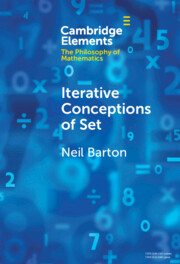Element contents
Iterative Conceptions of Set
Published online by Cambridge University Press: 15 May 2024
Summary
Information
- Type
- Element
- Information
- Online ISBN: 9781009227223Publisher: Cambridge University PressPrint publication: 13 June 2024
References
 collection, volume 6 of Lecture Notes in Logic, pages 307–22. Springer.CrossRefGoogle Scholar
collection, volume 6 of Lecture Notes in Logic, pages 307–22. Springer.CrossRefGoogle ScholarAccessibility standard: Unknown
Why this information is here
This section outlines the accessibility features of this content - including support for screen readers, full keyboard navigation and high-contrast display options. This may not be relevant for you.Accessibility Information
- 15
- Cited by
